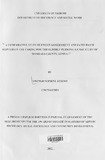| dc.description.abstract | The purpose of this study was to understand the services offered in both the Government and faith based eldercare institutions in relation to the needs of the elderly persons in Kenya. The target population included the elderly persons residing in both the Government home for the elderly (Nyumba va Wazee) and the faith based home for the elderly (Little Sisters) in Mombasa county, Coast Province, Kenya.
The study adopted descriptive research study design. Snowballing sampling technique was used in selection of study respondents. Five key informants were used to supplement the study findings. To complement each other, schedule-structured interviews, focus group discussion guide, observation checklist and in-depth interviews were used as key data collection instruments. The raw data from the field was analyzed using Statistical Package for Social Sciences (SPSS) and MS excel. Descriptive statistics were used in interpretation of findings. Here the main descriptive tools were; frequencies and percentages.
The study revealed that majority of the elderly persons understood the concept ‘old age’. They used their age as an indicator and considered themselves aged. The study also observed that a higher proportion (50% and 31 %) of the elderly persons had been in the Government and faith based homes respectively for 4-6 years. This was followed by 19% and 23% who had been in the homes for 1-3 years. This was due to low admission into the homes as the homes are already overwhelmed by the big numbers of the aged. Finally, 6% and 12% of the elderly persons had been in the homes for 16 years and above.
Findings showed that an overwhelming majority (94% and 77%) of the elderly from the Government and faith based homes respectively were taken to the homes by ‘others’. Here ‘others’ included; municipal askaris (53%), hospital staffs (27%), nuns (60%), priests (40%), self (13%) and finally chiefs (7%). It was evident that a smaller percentage of the elderly were taken to the homes by their children and relatives and this was because of the social distance that led to social isolation. It was evident that poverty, illness, disability, lack of caregiver and lack of a place to call home for the refugees were the main reasons as to why the elderly were taken to the homes.
XII
The study established that the aging have social, economic and physiological needs which they are unable to meet on their own unless through outside intervention. On the level of satisfaction with the services offered in the homes in trying to meet their needs, 43% and 77% of the elderly from the Government and faith based homes registered satisfaction, 44% and 19% registered dissatisfaction while the rest were not sure whether they were satisfied or not. It was evident that the elderly persons residing in the faith based home were more comfortable than those residing in the Government home. When asked whether they would wish to go back home given a chance, an overwhelming majority (85%) from the faith based home said no while majority (63%) from the government home were more than willing to go back home.
Findings revealed that there were various challenges that were facing both the elderly persons as well as the homes administration while in their respective homes. The elderly person’s challenges included; adjusting to life in the home for the elderly, lack of right for decision, participation, and freedom of choice, disability, chronic illness, ageism, pain of losing their friends through death and lack of finances. On the other hand the homes administration was challenged by lack of finances, caregiver burnout, getting and admitting genuine elderly person.
In conclusion, both the homes are doing their level best to deliver the best services to the elderly persons. Despite these efforts, the services in the faith based home were better than those in the Government home and this has led to more satisfaction in the faith based home as compared to the Government home | en_US |

